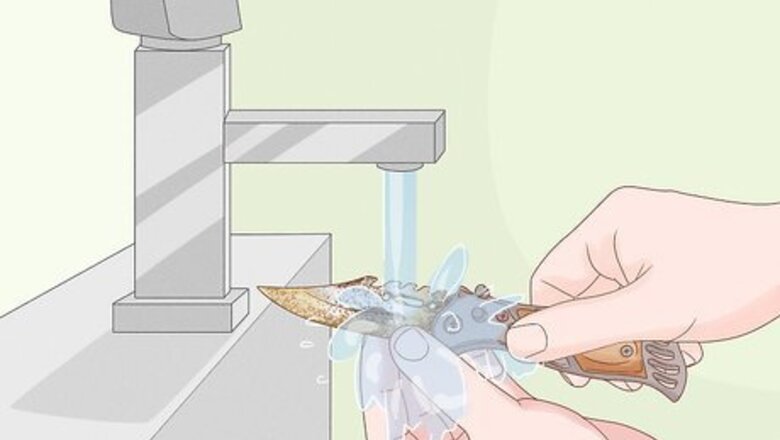
views
Using Natural Solvents
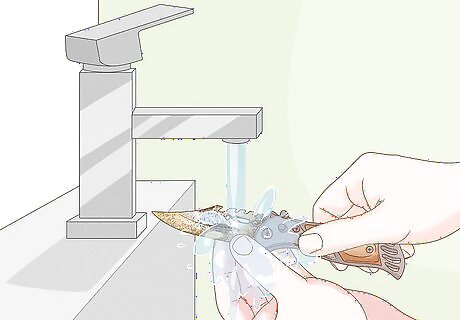
Clean your knife with water. Before you remove rust, make sure that the knife is free of dirt and oils. You can just hold your knife under some warm running water to clean it. Work slowly and be patient – if you rush the job, or scrub too vigorously, you risk damaging your knife. Use regular water to clean away any dirt or stains. Be sure to wipe away all traces of fingerprints, as the natural salts present in human skin can cause a blade to rust. Avoid getting water into the gaps between the handle and blade, where it may create new rust spots that are difficult to reach. Thoroughly dry your knife with a soft, clean rag after you finish cleaning it.
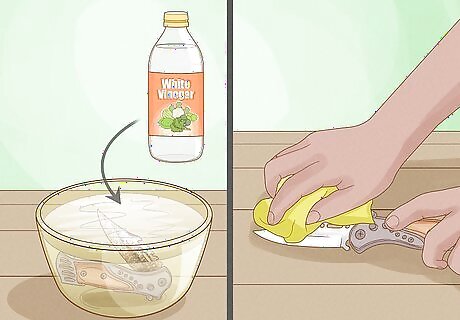
Soak your blade in white vinegar. White vinegar contains acetic acid, which will often dissolve rust. Dampen a rag with white vinegar and apply it directly to the rust spots, or soak the blade in a shallow bowl of white vinegar for tougher stains. Once the rust has dissolved, rinse the blade thoroughly with water to remove the vinegar. Then, dry off the knife with a clean, dry cloth.
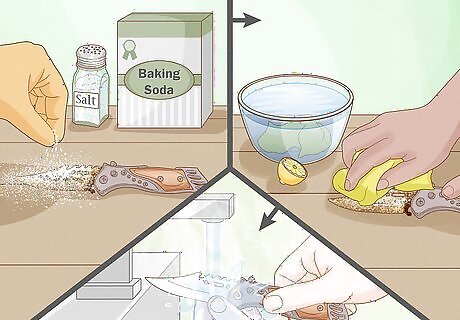
Apply some salt or baking soda and lemon juice. Lemon juice can dissolve rust stains on metal surfaces, but it may work even better when you use it with some salt or baking soda. Try using a mixture of lemon juice and salt or baking soda to remove rust stains from your knife blade. Sprinkle baking soda or salt onto the rust spots, then wipe the blade with a clean rag soaked in lemon juice. Rinse away the lemon juice with warm water after a minute or two and then dry it with a clean cloth. Be careful not to leave lemon juice on your blade for more than a few minutes, because it can damage the metal.
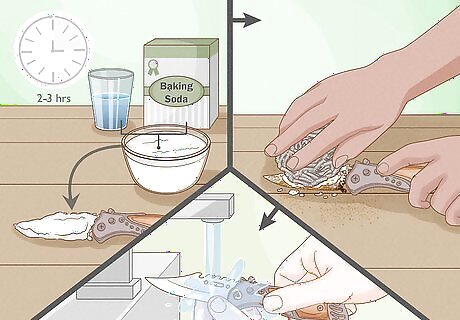
Use baking soda. Baking soda can remove rust stains, although you may need to repeat the process several times. Baking soda is used in cooking and for many house cleaning chores – you may already have some in your kitchen. Make a thick paste by mixing baking soda with water. Put about a quarter (1/4) cup of baking soda in a glass bowl, and add a small amount of water to create a paste. Continue to add water in small increments, until you have a paste that is thick enough to stick to the surface of the blade. Apply the paste to the blade, and allow it to soak for two to three hours. Scrub the paste off of the blade with a wire brush or fine steel wool to remove the rust spots. Rinse away the rest of the paste by holding the knife under running water. Then, dry the knife thoroughly with a clean cloth.
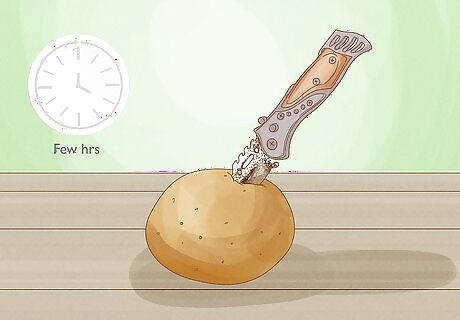
Stab the rusty knife into a potato. A raw potato may remove rust stains from metal surfaces. Potatoes contain oxalic acid, which can dissolve rust. Stick the rusted blade directly into a potato and leave it there for a few hours. Then, remove the knife from the potato, rinse away the potato juices, and dry the knife with a clean cloth. Throw away the potato after you are finished with it. It might have small pieces of rust stuck in it, so it is not suitable for eating.
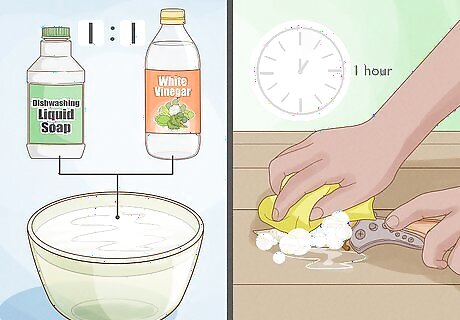
Mix white vinegar and dishwashing soap. Dishwashing soap mixed with vinegar can also remove rust stains from a knife. Get some regular dish soap and mix it with white cooking vinegar, or clear cleaning-grade vinegar. Mix one part dish soap with one part vinegar, and apply it to the blade with a soft rag. Then, rinse away the solution and dry off the knife. For stubborn rust stains, soak the blade in the vinegar dish soap solution for an hour. Then, remove the blade and rinse off the vinegar dish soap solution under running water. Dry off the blade with a clean, dry towel.
Using Abrasive Cleaners
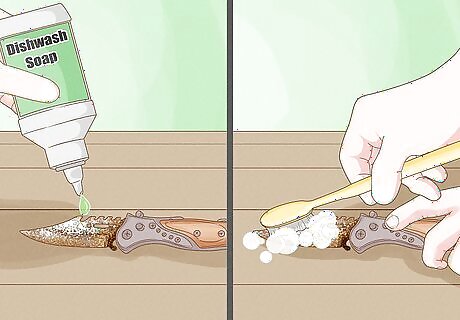
Scrub the knife with a toothbrush. Use an old toothbrush to remove grease, lint, and dirt from all surfaces of your knife. Try applying a bit of dish soap to the toothbrush and then use it to scrub all of the surfaces of your knife. For small, detailed areas, you can use a wooden toothpick or a cotton tipped swab (Q-Tip). Rinse away the soap after you are finished and then dry the knife with a clean cloth.
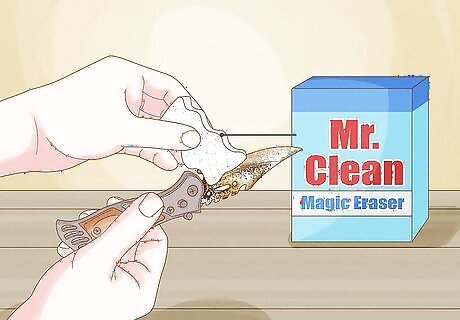
Try a magic eraser sponge. A magic eraser cleaning sponge may help to remove rust from your knife blade. You do not need to use any chemicals with a magic eraser. Just get it wet with a bit of water and it is ready to use. Use the magic eraser to scrub the rust spots off of your knife blade. Then, rinse off the blade and dry it with a clean cloth.
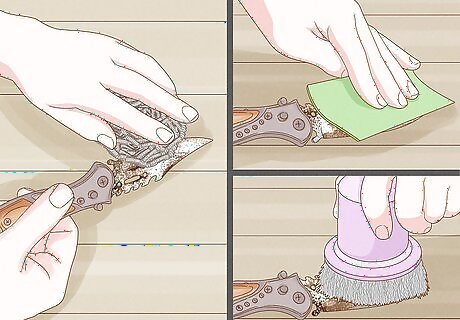
Use some steel wool or another abrasive tool. You can also try to scrub the rust stains from the blade using a piece of fine steel wool, fine-grit sandpaper, or a wire brush. You can scrub the blade while it is dry, or add a bit of water, or use some water and dish soap. If you do not have a steel brush or sandpaper, try using a crumpled ball of aluminum foil to scrub the blade. Make sure that you rinse the blade after you are finished and dry it off with a clean cloth.
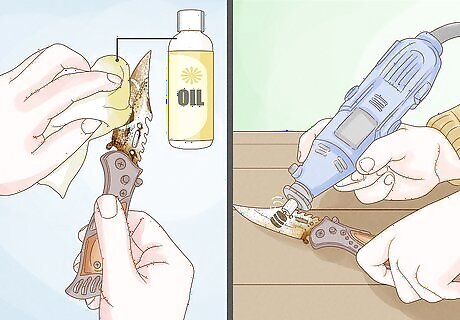
Clean the knife with a rotary tool to remove serious rust stains. If you cannot remove the rust with oil or cleansers alone, try using an electric rotary tool to remove the stains. Work slowly and carefully to avoid damaging the blade. Apply oil to the rusted blade before you use the rotary blade. Use a fine brass wire brush attachment on your rotary tool to remove surface rust. Secure the knife in a vice grip, and apply the wire brush tool to the blade in short, smooth movements. Change the brush attachment to a felt polishing wheel. Dip the wheel in polishing compound (such as 3-In-One, Clean Streak, or Metal Brite) and apply the wheel to the blade with smooth, short strokes. Switch to a clean polishing blade and finish with a paste polish such as Flitz . Buff the blade until it is smooth and shiny.
Using Chemical Solvents
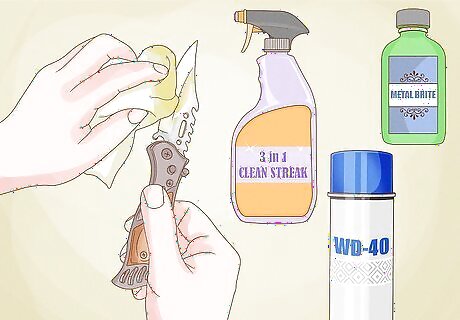
Oil the blade to remove light rust stains. Apply a light oil that will not stain or dry the metal components. You can use commercial products such as WD-40, 3-In-One, Clean Streak, and Metal Brite. Use a clean rag to apply a thin layer of oil directly to the blade. Use as little oil as possible because a thick layer of oil may attract dust and debris. Leave the knife open and allow the oil to soak into the blade for two to three days. This should loosen up the rust spots and make them easier to remove. After two to three days, use the tip of a sharp knife to carefully scrape off the rust spots. You can also use a piece of steel wool. If you work slowly and carefully, you can remove the rust while leaving much of the original finish of the blade intact.
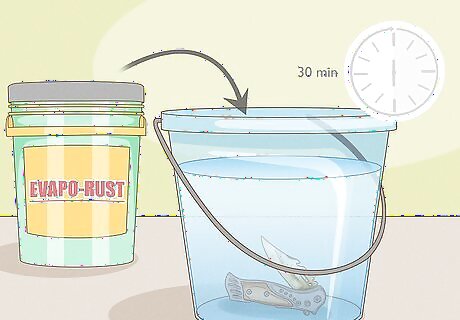
Use a non-toxic rust remover. You can purchase non-toxic rust removal products in hardware and auto parts stores, such as Evapo-Rust. These products are gentler than some of the other acid-based chemical solvents that you can use to remove rust. To use a product like Evapo-Rust, pour some of the product into a bucket and then immerse the knife blade in the solution. Leave the knife to soak in the solution for 30 minutes or overnight if it is really rusty. Rinse off the excess product and dry the knife with a clean, dry cloth.
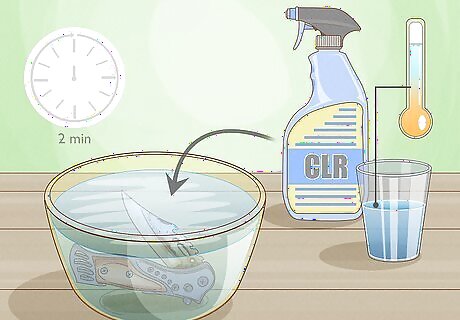
Try CLR for extra stubborn rust stains. CLR is a commercial cleaner that removes calcium, lime, and rust from any metal surface. It is often used on old plumbing and appliances, but it can also be used to remove rust from a knife blade. Dip the blade of your knife directly into a solution of half CLR and half warm water. Avoid getting CLR on the knife handle, if it is made of anything other than metal (e.g. plastic, bone, wood, stone). Rinse the blade right away with cold water. Do not soak the blade in CLR for any longer than two minutes, as this may damage the metal. If stains persist, use CLR at full strength (not diluted with water), and rinse right away with cold water. CLR is a caustic substance. Clean your knife in a well-ventilated area, and use gloves when handling CLR. Do not mix CLR with other household cleaners, as this may cause a dangerous reaction. Do not use CLR on galvanized metal, as it may cause spotting on the zinc coating of the blade.




















Comments
0 comment